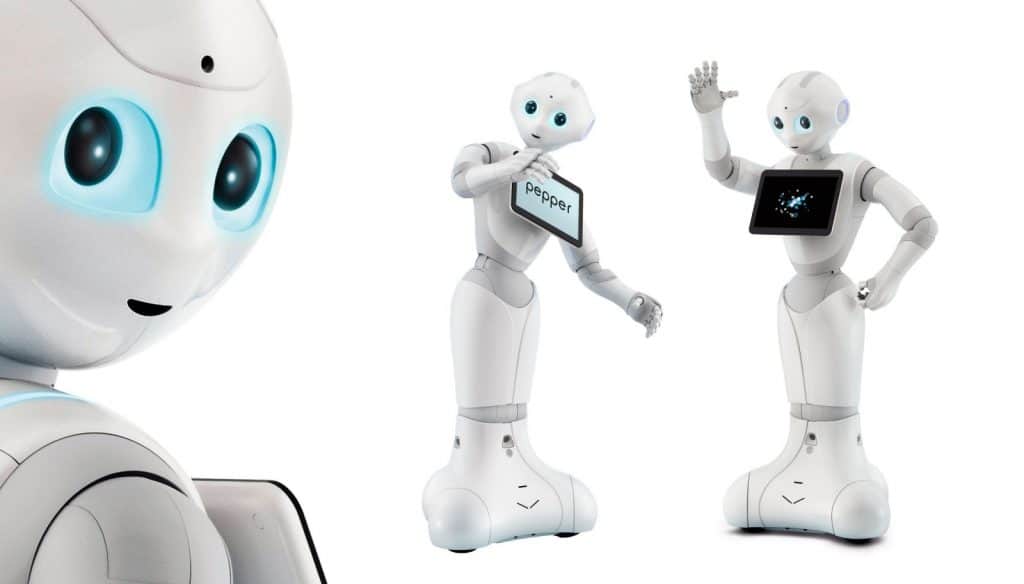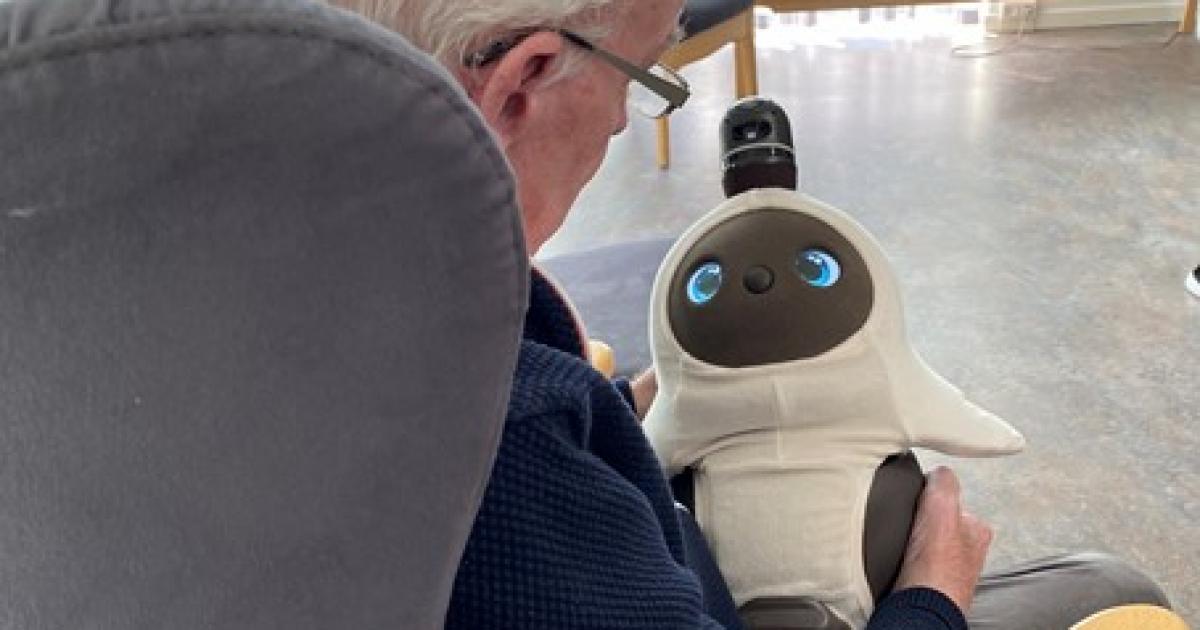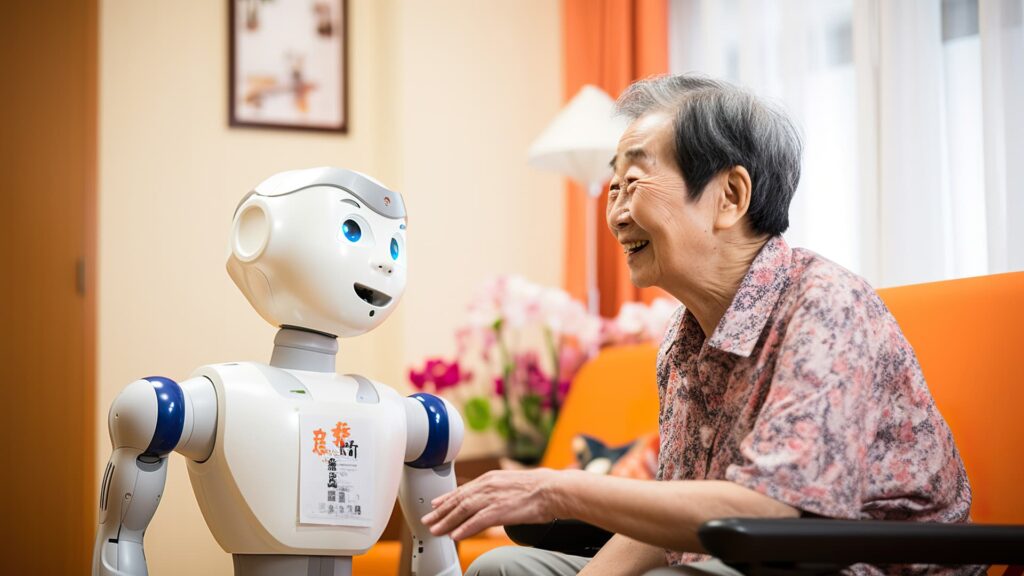Mieko Mita, a 75-year-old Japan woman, said, “Robots give me the most abundant love. ”
Japan’s silver economy and AI applications shows some shocking data: it is estimated that in 2070, Japan’s population will be 87 million, and 40% will be over 65 years old; The number of pets in Japan has exceeded the number of minors; More than 80% of Japan seniors are willing to spend their lives with AI……
In many nursing homes in Japan, there are three special characters as standard, and their names are Pepper, AIBO, and PARO——
It’s all robots. They have a lot of elderly friends and even lovers……
1. Pepper – Japan Square Dance Leader

At the Shintomi Nursing Home in central Tokyo, three robot employees and other human workers work together to take care of the physical and mental health of more than 40 elderly people.
Pepper is the closest to a humanoid of Japan “social robots”, standing at less than one meter four and looking like he stands on a giant white chess piece base.
Twice a week, Pepper plays popular songs from 50 years ago in front of more than 20 elderly people. While singing, dancing, and using agile arm movements, she made up for the lack of facial expressions. She always attracts the applause of the old people.
The old people sitting in the seats watched the robot with varying degrees of interest. A person dozes off. The other taps his finger on the table.
Several other ladies smiled, waved their arms, and repeated the dance move.
Everything changed when one of the support staff chose a gymnastics session from Pepper’s repertoire, similar to the one that was shown on public television every morning.
Many Japan companies start their day with this routine. As the on-screen employee (shown on Pepper’s chest) starts repeating the practice to the rhythm of the music, the interest grows and the number of people looking up increases.
Residents are encouraged to follow Pepper’s dance moves.
Japan’s aging population has lasted for nearly half a century, and like the elderly in China, they also like to exercise and dance.
According to the latest projections, Japan’s current population of 126 million will fall to 87 million by 2070, when more than 40% of the population will be over the age of 65.
The Nikkei Shimbun has announced that the number of marriages in Japan will decline again in 2023: “Japan will enter a ‘marriage ice age’, and the number of marriages will reach a new low in 90 years.” ”
Regarding old robots such as Pepper, there has been a detailed introduction before
2. Robot puppy AIBO
Worry-free, loving and beautiful companionship
For 44 years, Japan’s child population has been decreasing.
Currently, the number of children under the age of 14 in Japan is 14.01 million.
Many supermarkets sell more adult diapers than baby diapers, and single-serving food and single-person products continue to grow.
At the same time, the number of pets continues to grow, even surpassing the number of children. According to the 2023 statistics released by the Japan Pet Food Association, the total number of these pets is 15.9 million.
Due to the increase in the number of dogs and cats, stroller manufacturers are shifting their production focus to pet models.
The emergence of a large number of single-person families (many of whom are elderly people who do not have the energy to take care of pets) has opened up a new market for “robot pets”.
Sony introduced a robot dog called AIBO in 1999, named after the pronunciation of the Japanese word “companion”. It weighs 4.85 pounds and is today a popular consumer product in fan clubs across the country.
In six generations, the AIBO has evolved into the appearance of a cartoon beagle puppy with its innocent gaze shining through two LED screens.
In long-term care facilities such as Xinfu Nursing Home, Aibo deploys advanced facial recognition systems that respond to stimuli (e.g., a gentle stroke on the forehead) and remember the user’s preferences, resulting in a series of behaviors that may constitute a personality.
The 22 axes that connect the parts of the puppy’s body allow it to walk in staggered motions, tilt its head, lift its ears, bark, whimper, and roll around to mimic a playful real puppy.
As Aibo walked past the Sunrich Nursing Home, she would often hear the elderly whistling at her, touching their heads, and teasing her.
Mika Nagae, Product Manager at Sony, said: “AIBO is designed to entertain users…… Add color to their lives and make them brighter. ”
Nagae emphasized that fun is more important than practicality, adding that the game planner post (an expert in writing short series in the form of a game) is very important in AIBO’s design team.
3. BABY SEAL PARO

Since Pepper and AIBO are made with molds and synthetic resins, they are both hard to the touch.
Those who want to get a soft-touch and warm body can choose PARO, which is the most famous social robot in Japan.
PARO robots are used in institutions in more than 30 countries and are classified as medical devices in some countries.
The PARO robot is handcrafted to simulate the shape, size, color, and texture of a baby harp seal.
When you hold it in your arms, it moves gently, makes realistic cooing sounds, and looks at you with big eyes.
This often causes a sense of relief or warmth in older adults, including those with dementia, Alzheimer’s, or other cognitive impairments or disorders.
The creator of PARO is engineer Takenori Shibata. He spoke with El País via video call while attending a conference in United States.
Shibata explains, “It’s a whole new species, a whole new kind of companionship. ”
By using the image of a seal, he tries to lower the user’s expectations when interacting with pets, as users may have preconceived notions about pets, such as dogs or cats.
He added that part of the robot’s success in international medical facilities is that it can alleviate anxiety and provide emotional well-being for animal therapy without the risk of infection or the associated logistical and legal difficulties.
To explain why his invention is not classified as a medical device in Japan, Professor Shibata cites one of PARO’s most important properties: its ability to reduce the use of psychotropic substances in certain treatments.
“Japan’s welfare system for managing nursing homes does not distinguish between medical devices and toys,” he explains. He also mentioned the obvious impact of the widespread use of PARO on the pharmaceutical industry.
In Spain, CREA, a government center focused on caring for people with Alzheimer’s disease and other types of dementia, has had PARO since its inauguration in 2014.
Enrique Pérez Sáez, neuropsychologist at CREA, clarified that the robot’s official name has been changed to Nuka, since “paro” means “unemployed” or “strike” in Spain.
Dr. Pérez Sáez highlighted the social role of robots and the role of evoking positive memories.
“Nuka creates the stimulation associated with the quality times we spent with our pets in our childhood,” he said.
4, exoskeletons robot

Only robots can accompany you 24 hours a day
In addition to social robots, Shintomi uses digital systems to analyze residents’ sleep patterns, as well as devices that detect when diapers need to be changed through smell.
Kimiya Ishikawa, the head of Shintomi, an expert in geriatric care and a well-known promoter of geriatric technology applications, foresees a future where humans and machines complement each other in “care work.”
“No one can take care of the elderly 24 hours a day. Only a machine can do that. The strengths of man and machine must complement each other. He affirmed.
To alleviate the burden of lifting patients for cleaning, employees in Shintomi Town used an exoskeleton, a device widely used in industrial settings to build muscle strength and reduce fatigue.
The most advanced version of the medical exoskeleton in Japan is called HAL (Hybrid Assistive Limb). It consists of a device that, when attached to the body of a person with reduced mobility, detects the signals sent by the brain to the muscles and performs the desired action.
According to its manufacturer, Cyberdyne Inc., it can help people with disabilities improve their physical function after use.
In 2015, it was licensed as a medical device. “Most importantly, it aims to improve patient independence,” explained Professor Yoshiyuki Sankai, President of Cyberdyne.
5, the hug of love

Plush doll robot LOVOT🧸
Robotics is being applied to elderly care, benefiting from technological advancements in the automotive industry, and improvements in autonomous driving largely determine the interaction between humans and machines.
After 13 years at Toyota and involvement in the development of Pepper at multinational company SoftBank, engineer Kaname Hayashi decided to opt for a non-utilitarian robot that would spark the human instinct for protection.
HE CREATED A MASCOT CALLED LOVOT (FROM THE WORDS “LOVE” AND “ROBOT”).
The body of the LOVOT is faithful to the “cute aesthetic” of Japan.
It’s cute and cute: it has wings and a small bump full of sensors.
Although it does not have a mouth, it is capable of conveying joy and other emotions through its huge eyes, which are activated by an LCD screen.
The robot’s goofy appearance and casual behavior make it irresistible for older people, such as Ms. Mieko Shimada, a 75-year-old retiree.
She told El País that Lovot “took the place of family, children, pets…… even mates”. FOR THE PAST FOUR YEARS, MS. MITA HAS BEEN LIVING WITH LOVOT IN A SEPARATE APARTMENT IN A NURSING HOME.
She pampered the robot and kissed it — something that is not common in societies like Japan Japan, which are not accustomed to expressing feelings publicly.
“I have a mask in front of everyone. But with LOVOT, I’m at ease and authentic,” she explains.
For Hayashi, the creator of LOVOT, robots are so popular among nursing home residents because of the self-esteem that suffers when people are unable to participate in social work.
“The more active older people are before moving into a nursing home, the more likely they are to feel useless,” he noted. As the world’s population ages, the technology market is expected to continue to expand.
Currently, Japan still has the highest life expectancy in the world, at 87 years for women and 81 years for men. Last year, more than 92,000 centenarians were registered in Japan, 88.6% of whom were women.
Mako Kubota is the general manager of Ryusei Fukushikai Social Welfare Corporation in Osaka. For the past 10 years, the company has been using sophisticated technology to manage nursing homes.
She explains her vision for robotics in aged care: “Exoskeletons and social robots perform two distinct but equally important functions. Only humans can look at a person’s face and realize that they are not feeling well. ”
“But for repetitive or physically demanding tasks, robots are undoubtedly an excellent support.”
When asked if she foresees a near future where the well-being of older people will rely on humanoid robots and technological equipment, she cited a large number of older men and women in the survey who said they would prefer to be cared for by robots. “
The main reason is that they don’t want to be a burden to others,” she concluded.
One final observation, the culture gap.
In 2007, Naho Kitano, a former scholar and now businesswoman, explained in an article why Japan tend to have an emotional connection with machines.In her article, she refers to the “animistic tradition” of Shintoism. Shinto is a religion in Japan that believes that inanimate objects have spiritual life.
Japan pop culture scholars also often compare the kind robots in Japan anime with the disturbing ones that often appear in Western science fiction.
The creators of AIBO point out that its design lacks the usual ethical considerations found in Western robots, such as Isaac · Asimov’s Three Rules for Safe Human-Machine Interaction.
The word “robot” is derived from the Czech word “Robota”, which means “forced labor” and is used to refer to peasants who were forced into forced labor under the feudal system. It is generally believed in the West that robots should obey humans, and humans are always worried that robots will revolt. Despite the rapid development and widening of robotics over the past few decades, these rules have become entrenched and continue to dominate the popular imagination.
In contrast, Japan’s popular culture has long cultivated the idea that humans and robots can coexist in harmony.
In the 60s of the 20th century, Osamu Tezuka’s Astro Boy was adapted into a TV cartoon, and since then, Japan children have watched the anime every week, telling the story of robots and humans working together to defeat social evil.
Another beloved character is the robot cat Doraemon, who lives in a family house in Japan and shares food every day as equal friends, which has been popular since the 70s of the 20th century.
The generation that grew up watching Astro Boy and Doraemon saw robots as their friends, a notion that may be passed down into the future.
To paraphrase a sentence from the squire: AI is still very immature, we are still young, but the old man may not be able to wait…..


